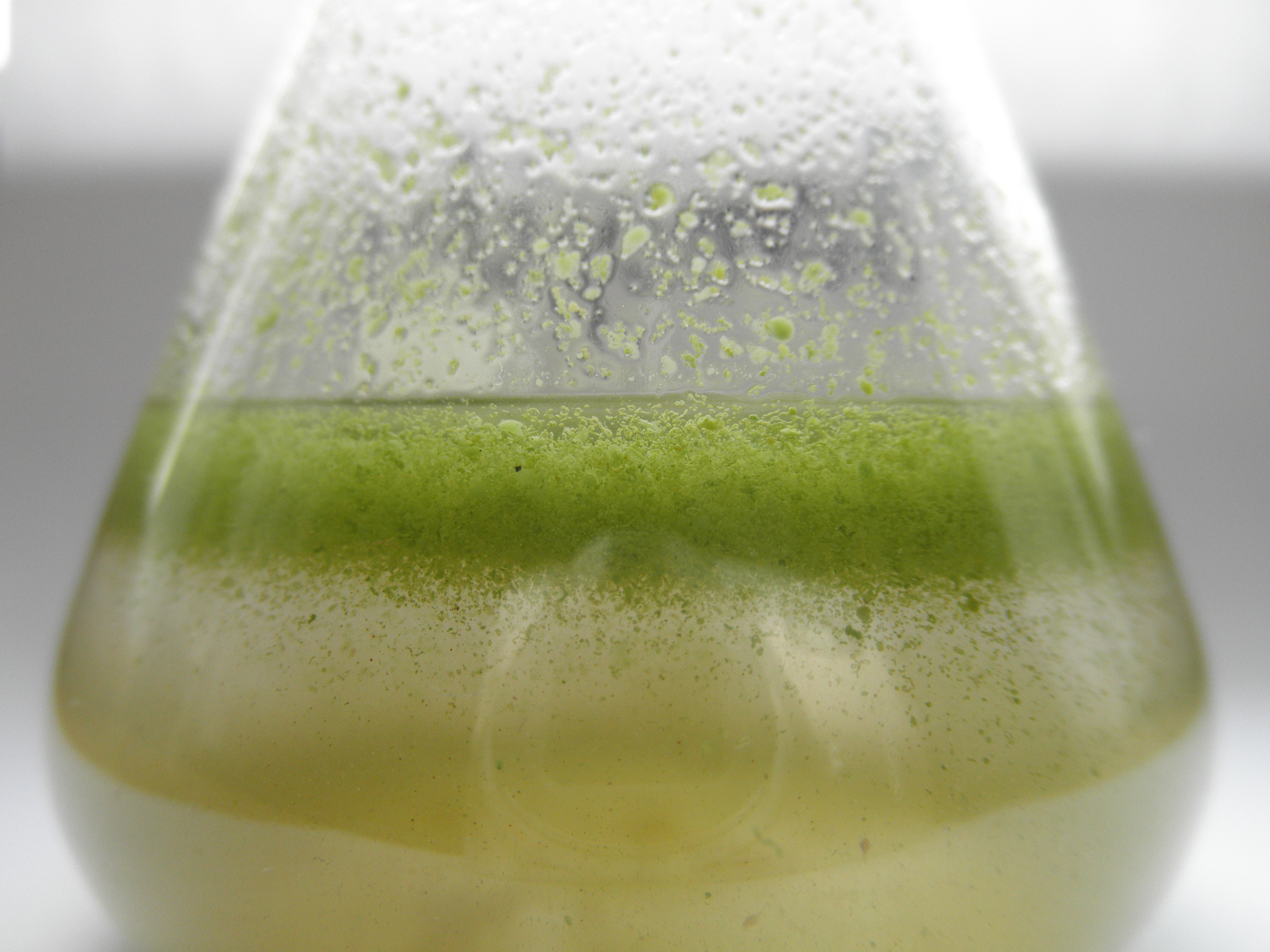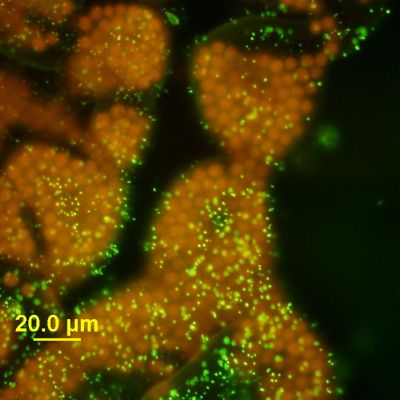Microcystis on:
[Wikipedia]
[Google]
[Amazon]
''Microcystis'' is a genus of freshwater
 As the etymological derivation implies, ''Microcystis'' is characterized by small cells (a few micrometers in diameter), possessing gas-filled vesicles (also lacking individual sheaths). The cells are usually organized into colonies (aggregations of which are visible with the naked eye) that begin in a spherical shape, losing coherence to become perforated or irregularly shaped over time. These colonies are bound by a thick mucilage composed of complex
As the etymological derivation implies, ''Microcystis'' is characterized by small cells (a few micrometers in diameter), possessing gas-filled vesicles (also lacking individual sheaths). The cells are usually organized into colonies (aggregations of which are visible with the naked eye) that begin in a spherical shape, losing coherence to become perforated or irregularly shaped over time. These colonies are bound by a thick mucilage composed of complex

 ''Microcystis'' is capable of producing large surface blooms through a combination of rapid division and buoyancy regulation by production of gas-filled vesicles. In nature, ''Microcystis'' can exist as single cells or in large colonies containing many cells. Their ability to regulate buoyancy is one of the keys to their dominance of
''Microcystis'' is capable of producing large surface blooms through a combination of rapid division and buoyancy regulation by production of gas-filled vesicles. In nature, ''Microcystis'' can exist as single cells or in large colonies containing many cells. Their ability to regulate buoyancy is one of the keys to their dominance of
Great Lakes Center for Fresh Waters and Human Health
was founded at Bowling Green State University (OH) with a focus on problems associated with ''Microcystis'' blooms in the Laurentian Great Lakes. Under the leadership of inaugural director George S. Bullerjahn, the center engages scientists from nine institutions across six states, and is supported by combined funding from the National Science Foundation and National Institute of Environmental Health Sciences.
cyanobacteria
Cyanobacteria (), also known as Cyanophyta, are a phylum of gram-negative bacteria that obtain energy via photosynthesis. The name ''cyanobacteria'' refers to their color (), which similarly forms the basis of cyanobacteria's common name, bl ...
that includes the harmful algal bloom-forming ''Microcystis aeruginosa
''Microcystis aeruginosa'' is a species of freshwater cyanobacteria that can form harmful algal blooms of economic and ecological importance. They are the most common toxic cyanobacterial bloom in eutrophic fresh water. Cyanobacteria produce ne ...
''. Many members of a ''Microcystis'' community can produce neurotoxin
Neurotoxins are toxins that are destructive to nerve tissue (causing neurotoxicity). Neurotoxins are an extensive class of exogenous chemical neurological insultsSpencer 2000 that can adversely affect function in both developing and mature nerv ...
s and hepatotoxins, such as microcystin
Microcystins—or cyanoginosins—are a class of toxins produced by certain freshwater cyanobacteria, commonly known as blue-green algae. Over 250 different microcystins have been discovered so far, of which microcystin-LR is the most common. C ...
and cyanopeptolin Cyanopeptolins (CPs) are a class of oligopeptides produced by Microcystis and Planktothrix algae strains, and can be neurotoxic. The production of cyanopeptolins occurs through nonribosomal peptides synthases (NRPS).
Chemistry
CPs are, in general ...
. Communities are often a mix of toxin-producing and nonproducing isolates.
Etymology
The genus ''Microcystis'' derives from the Greek ''mikros'' (small) + ''kystis'' (bladder)Physical characteristics
 As the etymological derivation implies, ''Microcystis'' is characterized by small cells (a few micrometers in diameter), possessing gas-filled vesicles (also lacking individual sheaths). The cells are usually organized into colonies (aggregations of which are visible with the naked eye) that begin in a spherical shape, losing coherence to become perforated or irregularly shaped over time. These colonies are bound by a thick mucilage composed of complex
As the etymological derivation implies, ''Microcystis'' is characterized by small cells (a few micrometers in diameter), possessing gas-filled vesicles (also lacking individual sheaths). The cells are usually organized into colonies (aggregations of which are visible with the naked eye) that begin in a spherical shape, losing coherence to become perforated or irregularly shaped over time. These colonies are bound by a thick mucilage composed of complex polysaccharide
Polysaccharides (), or polycarbohydrates, are the most abundant carbohydrates found in food. They are long chain polymeric carbohydrates composed of monosaccharide units bound together by glycosidic linkages. This carbohydrate can react with w ...
compounds, including xylose
Xylose ( grc, ξύλον, , "wood") is a sugar first isolated from wood, and named for it. Xylose is classified as a monosaccharide of the aldopentose type, which means that it contains five carbon atoms and includes an aldehyde functional g ...
, mannose
Mannose is a sugar monomer of the aldohexose series of carbohydrates. It is a C-2 epimer of glucose. Mannose is important in human metabolism, especially in the glycosylation of certain proteins. Several congenital disorders of glycosylat ...
, glucose
Glucose is a simple sugar with the molecular formula . Glucose is overall the most abundant monosaccharide, a subcategory of carbohydrates. Glucose is mainly made by plants and most algae during photosynthesis from water and carbon dioxide, u ...
, fucose, galactose, and rhamnose
Rhamnose (Rha, Rham) is a naturally occurring deoxy sugar. It can be classified as either a methyl-pentose or a 6-deoxy- hexose. Rhamnose predominantly occurs in nature in its L-form as L-rhamnose (6-deoxy-L-mannose). This is unusual, since most ...
, among other compounds.
The coloration of the protoplast
Protoplast (), is a biological term coined by Hanstein in 1880 to refer to the entire cell, excluding the cell wall. Protoplasts can be generated by stripping the cell wall from plant, bacterial, or fungal cells by mechanical, chemical or e ...
is a light blue-green, appearing dark or brown due to optical effects of gas-filled vesicles
Vesicle may refer to:
; In cellular biology or chemistry
* Vesicle (biology and chemistry), a supramolecular assembly of lipid molecules, like a cell membrane
* Synaptic vesicle
; In human embryology
* Vesicle (embryology), bulge-like features o ...
.
Ecology

 ''Microcystis'' is capable of producing large surface blooms through a combination of rapid division and buoyancy regulation by production of gas-filled vesicles. In nature, ''Microcystis'' can exist as single cells or in large colonies containing many cells. Their ability to regulate buoyancy is one of the keys to their dominance of
''Microcystis'' is capable of producing large surface blooms through a combination of rapid division and buoyancy regulation by production of gas-filled vesicles. In nature, ''Microcystis'' can exist as single cells or in large colonies containing many cells. Their ability to regulate buoyancy is one of the keys to their dominance of eutrophic
Eutrophication is the process by which an entire body of water, or parts of it, becomes progressively enriched with minerals and nutrients, particularly nitrogen and phosphorus. It has also been defined as "nutrient-induced increase in phytoplan ...
waters, by optimally positioning themselves within the photic zone
The photic zone, euphotic zone, epipelagic zone, or sunlight zone is the uppermost layer of a body of water that receives sunlight, allowing phytoplankton to perform photosynthesis. It undergoes a series of physical, chemical, and biological pro ...
in a stable water column.
Because they can form large surface blooms, they are thought to be able to outcompete other phytoplankton
Phytoplankton () are the autotrophic (self-feeding) components of the plankton community and a key part of ocean and freshwater ecosystems. The name comes from the Greek words (), meaning 'plant', and (), meaning 'wanderer' or 'drifter'.
...
by monopolizing light in the photic zone.
''Microcystis'' spp. are also capable of efficient uptake of phosphate and nitrogen; they are believed to be strongly influenced by nitrogen to phosphorus ratios ( N:P ratio). ''Microcystis'' cells are also efficient at assimilating carbon from their environment; during large blooms, rampant photosynthesis can drive the pH of communities to < 9.0. Recent efforts have suggested a combination of effective carbon-concentrating mechanisms and a potential ability to use urea as both a carbon and nitrogen source allows ''Microcystis'' to persist under these high-pH conditions.
In South Africa, Hartebeestpoort Dam is highly impacted by ''Microcystis'' because of elevated phosphate and nitrate levels flowing from the sewers of Johannesburg, one of the few cities in the world that straddles a continental watershed divide, so lies upstream of major dams and rivers.
In North America, ''Microcystis'' blooms have caused issues in numerous freshwater systems over the last two decades. These include large lakes (Erie, Okeechobee) and small regional water masses like Ohio's Grand Lake St Marys. In 2014, detection of the microcystin toxin in treated water of Toledo (OH) resulted in a shutdown of the water supply to more than 400,000 residents. The breakthrough of the toxin in the system was linked to the presence of a virus that lysed cells and released the toxin out of particles into the dissolved phase.
Health risks
Cyanobacteria can produceneurotoxin
Neurotoxins are toxins that are destructive to nerve tissue (causing neurotoxicity). Neurotoxins are an extensive class of exogenous chemical neurological insultsSpencer 2000 that can adversely affect function in both developing and mature nerv ...
s and hepatotoxins, such as microcystin
Microcystins—or cyanoginosins—are a class of toxins produced by certain freshwater cyanobacteria, commonly known as blue-green algae. Over 250 different microcystins have been discovered so far, of which microcystin-LR is the most common. C ...
and cyanopeptolin Cyanopeptolins (CPs) are a class of oligopeptides produced by Microcystis and Planktothrix algae strains, and can be neurotoxic. The production of cyanopeptolins occurs through nonribosomal peptides synthases (NRPS).
Chemistry
CPs are, in general ...
. ''Microcystis'' has also been reported to produce a compound (or compounds) that can have endocrine-disrupting effects. In 2018, thGreat Lakes Center for Fresh Waters and Human Health
was founded at Bowling Green State University (OH) with a focus on problems associated with ''Microcystis'' blooms in the Laurentian Great Lakes. Under the leadership of inaugural director George S. Bullerjahn, the center engages scientists from nine institutions across six states, and is supported by combined funding from the National Science Foundation and National Institute of Environmental Health Sciences.
Species
''Microcystis'' species include: *''Microcystis aeruginosa
''Microcystis aeruginosa'' is a species of freshwater cyanobacteria that can form harmful algal blooms of economic and ecological importance. They are the most common toxic cyanobacterial bloom in eutrophic fresh water. Cyanobacteria produce ne ...
''
*''Microcystis argentea
''Microcystis'' is a genus of freshwater cyanobacteria that includes the harmful algal bloom-forming ''Microcystis aeruginosa''. Many members of a ''Microcystis'' community can produce neurotoxins and hepatotoxins, such as microcystin and cya ...
''
*''Microcystis botrys
''Microcystis'' is a genus of freshwater cyanobacteria that includes the harmful algal bloom-forming ''Microcystis aeruginosa''. Many members of a ''Microcystis'' community can produce neurotoxins and hepatotoxins, such as microcystin and cya ...
''
*''Microcystis elongata
''Microcystis'' is a genus of freshwater cyanobacteria that includes the harmful algal bloom-forming '' Microcystis aeruginosa''. Many members of a ''Microcystis'' community can produce neurotoxins and hepatotoxins, such as microcystin and ...
''
*''Microcystis flos-aquae
''Microcystis'' is a genus of freshwater cyanobacteria that includes the harmful algal bloom-forming ''Microcystis aeruginosa''. Many members of a ''Microcystis'' community can produce neurotoxins and hepatotoxins, such as microcystin and cya ...
''
*'' Microcystis holsatica''
*'' Microcystis lutescens''
*'' Microcystis marina''
*'' Microcystis pallida''
*'' Microcystis panniformis''
*'' Microcystis salina''
*'' Microcystis thermalis''
*'' Microcystis viridis''
*'' Microcystis wesenbergii''
See also
*'' Pandorina'' (Analogy
Analogy (from Greek ''analogia'', "proportion", from ''ana-'' "upon, according to" lso "against", "anew"+ ''logos'' "ratio" lso "word, speech, reckoning" is a cognitive process of transferring information or meaning from a particular subject ...
)
References
{{Taxonbar, from=Q309928 Chroococcales Cyanobacteria genera